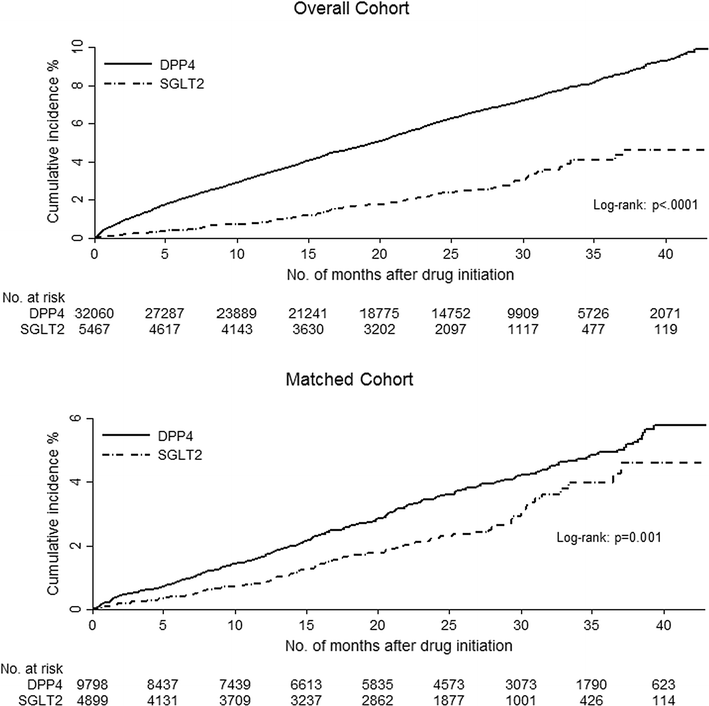Heart failure hospitalization risk associated with use of two classes of oral antidiabetic medications: an observational, real-world analysis
- PMID: 28756774
- PMCID: PMC5535291
- DOI: 10.1186/s12933-017-0575-x
Heart failure hospitalization risk associated with use of two classes of oral antidiabetic medications: an observational, real-world analysis
Abstract
Background: Newer oral antidiabetic drug classes are expanding treatment options for type 2 diabetes mellitus (T2DM); however, concerns remain. The objective was to assess relative risk of heart failure hospitalization of sodium-glucose co-transporter-2 (SGLT2) and dipeptidyl peptidase-4 (DPP4) inhibitors in T2DM patients.
Methods: This retrospective observational study used a national commercially insured claims database. Adults (>18 years) with T2DM newly starting SGLT2 or DPP4 medication between April 2013 and December 2014 were included. Depending on their index fill, patients were grouped into either SGLT2 or DPP4 medication class cohorts. The primary outcome was hospitalization for heart failure and the risk was assessed using Cox regression models. Propensity score matching (1:2 ratio) was used to adjust for potential confounders. Analyses were also stratified by the presence of baseline diabetes complication and age (<65 vs 65+).
Results: The matched cohort included 4899 SGLT2 and 9798 DPP4 users. The risk of heart failure hospitalization was lower among SGLT2 users in comparison with matched DPP4 users (2.0% SGLT2 vs 3.1% DPP4; adjusted hazard ratio [aHR] 0.68; 95% confidence interval [CI] 0.54-0.86; p = .001). However, the stratified analyses revealed no risk difference among the majority of the analyzed patients, i.e., those aged <65, which comprised 85% of the matched cohort (aHR = 0.78; 95% CI 0.57-1.05; p = .09), and those without prior complication, which comprised 69% of matched cohort (aHR = 0.83; 95% CI 0.54-1.27; p = 0.40).
Conclusions: In this real-life analysis, the rate of hospitalizations for heart failure was significantly lower for patients initiating an SGLT2 compared with a DPP4 medication, specifically among older patients and those with diabetes complication.
Keywords: Claims analysis; DPP4; Heart failure; OAD; SGLT2; Type 2 diabetes.
Figures
Similar articles
-
Demographic and Clinical Profiles of Type 2 Diabetes Mellitus Patients Initiating Canagliflozin Versus DPP-4 Inhibitors in a Large U.S. Managed Care Population.J Manag Care Spec Pharm. 2015 Dec;21(12):1204-12. doi: 10.18553/jmcp.2015.21.12.1204. J Manag Care Spec Pharm. 2015. PMID: 26679969 Free PMC article.
-
Contemporary use of SGLT2 inhibitors in heart failure patients with diabetes mellitus: a comparison of DPP4 inhibitors in a nationwide electric health database of the superaged society.Cardiovasc Diabetol. 2022 Aug 13;21(1):157. doi: 10.1186/s12933-022-01586-6. Cardiovasc Diabetol. 2022. PMID: 35964039 Free PMC article.
-
Risks of cardiovascular diseases associated with dipeptidyl peptidase-4 inhibitors and other antidiabetic drugs in patients with type 2 diabetes: a nation-wide longitudinal study.Cardiovasc Diabetol. 2016 Mar 1;15:41. doi: 10.1186/s12933-016-0350-4. Cardiovasc Diabetol. 2016. PMID: 26932742 Free PMC article.
-
Real-world adherence, persistence, and in-class switching during use of dipeptidyl peptidase-4 inhibitors: a systematic review and meta-analysis involving 594,138 patients with type 2 diabetes.Acta Diabetol. 2021 Jan;58(1):39-46. doi: 10.1007/s00592-020-01590-w. Epub 2020 Aug 18. Acta Diabetol. 2021. PMID: 32809070
-
Clinical use of dipeptidyl peptidase-4 and sodium-glucose cotransporter 2 inhibitors in combination therapy for type 2 diabetes mellitus.Postgrad Med. 2015 Jun;127(5):463-79. doi: 10.1080/00325481.2015.1044756. Epub 2015 May 8. Postgrad Med. 2015. PMID: 25956345 Review.
Cited by
-
Heart failure and the prognostic impact and incidence of new-onset of diabetes mellitus: a nationwide cohort study.Cardiovasc Diabetol. 2019 Jun 12;18(1):79. doi: 10.1186/s12933-019-0883-4. Cardiovasc Diabetol. 2019. PMID: 31189473 Free PMC article.
-
Real-world evaluation of sodium-glucose co-transporter-2 inhibitors and dipeptidyl peptidase-4 inhibitors for managing type 2 diabetes mellitus: a retrospective multi-ethnic cohort study.J Diabetes Metab Disord. 2022 Mar 3;21(1):521-555. doi: 10.1007/s40200-022-01004-4. eCollection 2022 Jun. J Diabetes Metab Disord. 2022. PMID: 35673518 Free PMC article.
-
Benefit and Safety of Sodium-Glucose Co-Transporter 2 Inhibitors in Older Patients with Type 2 Diabetes Mellitus.Diabetes Metab J. 2024 Sep;48(5):837-846. doi: 10.4093/dmj.2024.0317. Epub 2024 Sep 1. Diabetes Metab J. 2024. PMID: 39313229 Free PMC article. Review.
-
Healthcare Costs and Resource Utilization Associated with the Use of Empagliflozin Versus Other Antihyperglycemic Agents Among Patients with Type 2 Diabetes Mellitus and Cardiovascular Disease: A Real-World Retrospective Cohort Analysis.Diabetes Ther. 2022 Jan;13(1):25-42. doi: 10.1007/s13300-021-01173-0. Epub 2021 Nov 2. Diabetes Ther. 2022. PMID: 34727356 Free PMC article.
-
Sodium-Glucose Co-Transporter 2 Inhibitors (SGLT2i) Exposure and Outcomes in Type 2 Diabetes: A Systematic Review of Population-Based Observational Studies.Diabetes Ther. 2021 Apr;12(4):991-1028. doi: 10.1007/s13300-021-01004-2. Epub 2021 Mar 4. Diabetes Ther. 2021. PMID: 33665777 Free PMC article. Review.
References
-
- National diabetes statistics report, 2014. http://www.cdc.gov/diabetes/pdfs/data/2014-report-estimates-of-diabetes-.... Accessed 8 Nov 2016.
-
- Geiss LS, Li Y, Kirtland K, Barker L, Burrows NR, Gregg EW. Increasing prevalence of diagnosed diabetes—United States and Puerto Rico, 1995–2010. MMWR. 2012;61(45):918–921. - PubMed
Publication types
MeSH terms
Substances
LinkOut - more resources
Full Text Sources
Other Literature Sources
Medical
Miscellaneous



